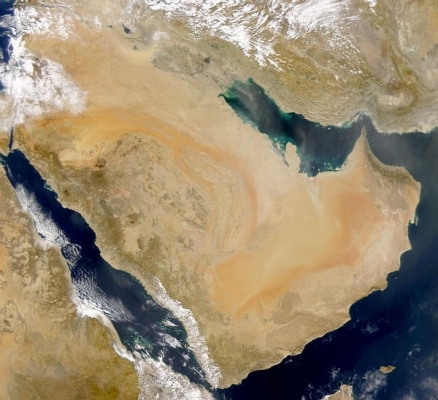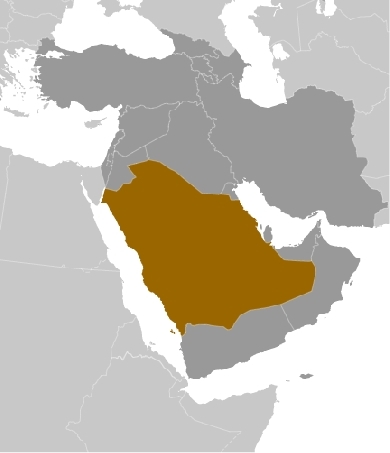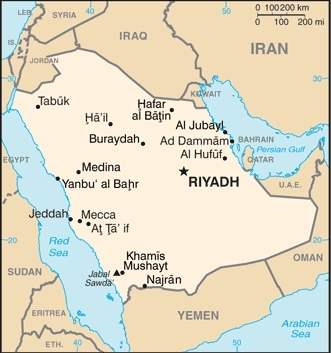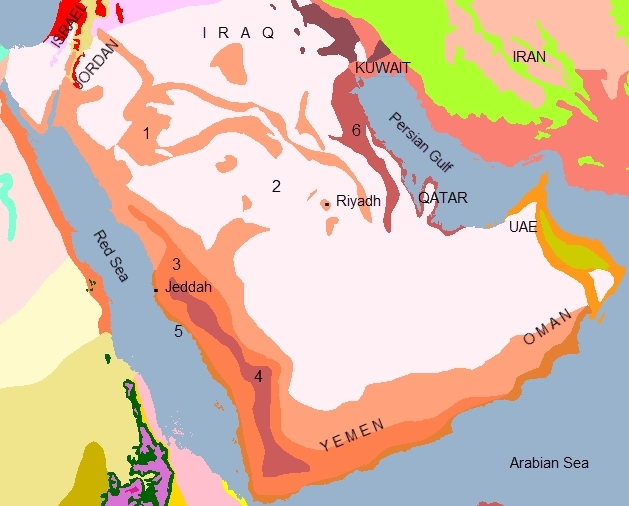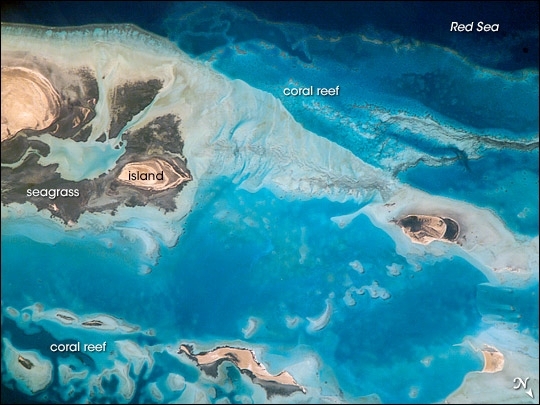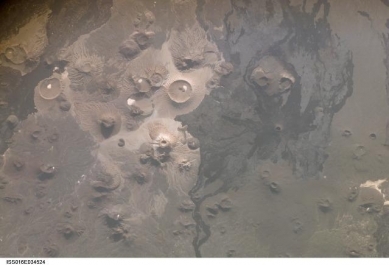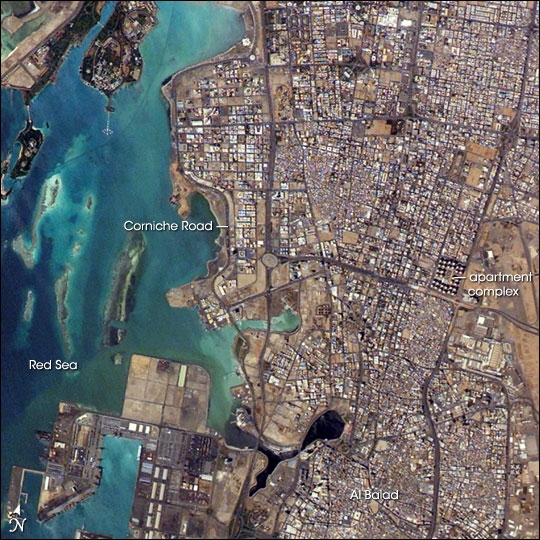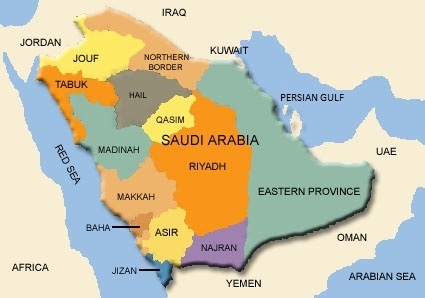Saudi Arabia (Ecology)
Contents
Saudi Arabia
Countries and Regions of the World Collection  Saudi Arabia is a nation of about 26 million people in the Middle East, bordering the Persian Gulf and the Red Sea, north of Yemen.
Saudi Arabia is a nation of about 26 million people in the Middle East, bordering the Persian Gulf and the Red Sea, north of Yemen.
Saudi Arabia has an oil-based economy with strong government controls over major economic activities. It possesses about 20% of the world's proven petroleum reserves and ranks as the largest exporter of petroleum.
Its major environmental issues include:
- desertification;
- depletion of underground water resources;
- the lack of perennial rivers or permanent water bodies has prompted the development of extensive seawater desalination facilities; and,
- coastal pollution from oil spills
Saudi Arabia is susceptible to frequent sand and dust storms.
Saudi Arabia is the birthplace of Islam and home to Islam's two holiest shrines in Mecca and Medina. The king's official title is the Custodian of the Two Holy Mosques.
The modern Saudi state was founded in 1932 by Abd Al-Aziz bin Abd al-Rahman Al Saud (Ibn Saud) after a 30-year campaign to unify most of the Arabian Peninsula. A male descendent of Ibn Saud, his son Abdallah bin Abd al-Aziz, rules the country today as required by the country's 1992 Basic Law.
Following Iraq's invasion of Kuwait in 1990, Saudi Arabia accepted the Kuwaiti royal family and 400,000 refugees while allowing Western and Arab troops to deploy on its soil for the liberation of Kuwait the following year.
The continuing presence of foreign troops on Saudi soil after the liberation of Kuwait became a source of tension between the royal family and the public until all operational US troops left the country in 2003.
Major terrorist attacks in May and November 2003 spurred a strong on-going campaign against domestic terrorism and extremism.
King Abdallah has continued the cautious reform program begun when he was crown prince. To promote increased political participation, the government held elections nationwide from February through April 2005 for half the members of 179 municipal councils. In December 2005, King Abdallah completed the process by appointing the remaining members of the advisory municipal councils. The king instituted an Inter-Faith Dialogue initiative in 2008 to encourage religious tolerance on a global level; in February 2009, he reshuffled the cabinet, which led to more moderates holding ministerial and judicial positions, and appointed the first female to the cabinet.
The country remains a leading producer of oil and natural gas and holds more than 20% of the world's proven oil reserves.
The government continues to pursue economic reform and diversification, particularly since Saudi Arabia's accession to the WTO in December 2005, and promotes foreign investment in the kingdom.
A burgeoning population, aquifer depletion, and an economy largely dependent on petroleum output and prices are all ongoing governmental concerns.
The 2010-11 uprising across Middle Eastern and North African countries sparked modest incidents in Saudi cities, predominantly by Shia demonstrators calling for the release of detainees and the withdrawal from Bahrain of the Gulf Cooperation Council's Peninsula Shield Force. Other relatively minor, non-Shia demonstrations focused on labor, prisoner, and infrastructure complaints. Protests in general were met by a strong police presence, with some arrests, but not the bloodshed seen in protests elsewhere in the region.
King Abdallah in February and March 2011 announced a series of benefits to Saudi citizens including funds to build affordable housing, salary increases for government workers, and unemployment benefits. The King also announced that Riyadh would begin preparations for a second round of municipal elections in September 2011.
It's extensive coastlines on Persian Gulf and Red Sea provide great leverage on shipping (especially crude oil) through Persian Gulf and Suez Canal.
Geography
Location: Middle East, bordering the Persian Gulf and the Red Sea, north of Yemen
Geographic Coordinates: 25 00 N, 45 00 E
Area: 2,149,690 sq km
Land Boundaries: 4,431 km (Iraq 814 km, Jordan 744 km, Kuwait 222 km, Oman 676 km, Qatar 60 km, UAE (United Arab Emirates) 457 km, Yemen 1,458 km)
Saudi Arabia has reinforced its concrete-filled security barrier along sections of the now fully demarcated border with Yemen to stem illegal cross-border activities.
Coastline: 2,640 km
Maritime Claims:
territorial sea: 12 nm
contiguous zone: 18 nm
continental shelf: not specified
Kuwait and Saudi Arabia continue discussions on a maritime boundary with Iran.
Saudi Arabia claims Egyptian-administered islands of Tiran and Sanafir.
Natural Hazards: frequent sand and dust storms
Terrain: mostly uninhabited, sandy desert. The highest point is Jabal Sawda' (3,133 m).
Climate: harsh, dry desert with great temperature extremes
Tolopolgy of Saudi Arabia. Source: Mediawiki Commons.
Ecology and Biodiversity
- Red Sea Nubo-Sindian tropical desert and semi-desert
- Arabian Desert and East Sahero-Arabian xeric shrublands
- Southwestern Arabian foothills savanna
- Southwestern Arabian montane woodlands
- Arabian Peninsula coastal fog desert
- Persian Gulf desert and semi-desert
See also:
Al Wadj Bank, Saudi Arabia. Saudi Arabia boasts the most coral reefs of any Middle Eastern country, as it includes coastline along both the Red Sea and the Persian Gulf. This high-resolution astronaut photograph shows part of the Al Wadj Bank, located along the northern Red Sea coast. Despite the relatively high salinity of Red Sea water (compared to other oceans), approximately 260 species of coral have been documented in the region. Large tracts of the Saudi Arabian coastline are undeveloped, and reefs in these areas are in generally good ecological health. However, reefs located near large urban centers such as Jeddeh have suffered degradation due to land reclamation (dredging and filling), pollution, and increased sediment runoff from land.
The Al Wadj Bank (a bank is an underwater hill) includes a healthy and diverse reef system, extensive seagrass beds, and perhaps the largest population of dugong—a marine mammal similar to the North American manatee—in the eastern Red Sea. The portion of the Bank in this image illustrates the complex form and topography of the reef system. Several emergent islands (tan) are visible, surrounded primarily by dark green seagrass; the largest is at top left. Only the islands are above the waterline; over the reefs, the water color ranges from light teal (shallow) to turquoise (increasing depth). The southern edge of the reef is well defined by the deep, dark blue water of the Red Sea (top).
In recent years, countries that border the Red Sea have cooperated to form a regional conservation plan for reef ecosystems. The plan includes the designation of several Marine Protected Areas (MPAs), integrated coastal management plans, improved pollution controls, reef health monitoring, and public education efforts. The Al Wadj Bank is one of the areas designated as a MPA.
Coastal areas along the Jeddah Corniche were in-filled with 700,000 cubic metres in only a one year period and dredged extensively. The disturbed sediments and poorly treated sewage danage the nearby reefs. Jeddah produces more than 800 000 cubic metres of wastewater per day which is discharged into the sea. Overfishing and anchoring on coral reefs is also damaging to reefs. At least eight shipping accidents occurred in the port during the single period 2006-2007 damaging more than 600 square metres of coral reefs. (Kotb et al, 2008)
People and Society
Population: 26,534,504 (July 2012 est.) Note: includes 5,576,076 non-nationals.
Until the 1960s, most of the population was nomadic or seminomadic; due to rapid economic and urban growth, more than 95% of the population now is settled. Some cities and oases have densities of more than 1,000 people per square kilometer (2,600 per sq. mi).
Saudi Arabia is known as the birthplace of Islam, which in the century following the Prophet Muhammad's death in 632 A.D. spread west to Spain and east to India. Islam obliges all Muslims to make the Hajj, or pilgrimage to Makkah, at least once during their lifetime if they are able to do so. The cultural environment in Saudi Arabia is highly conservative; the country officially adheres to the strict Wahhabi interpretation of Islamic religious law (Shari'a). Cultural presentations must conform to narrowly defined standards of ethics. Men and women often are not permitted to attend public events together and are segregated in the work place.
Most Saudis are ethnically Arab. Some are of mixed ethnic origin and are descended from Turks, Iranians, Indonesians, Indians, Africans, and others, most of whom immigrated as pilgrims and reside in the Hijaz region along the Red Sea coast. Many Arabs from nearby countries are employed in the kingdom. There also are significant numbers of Asian expatriates mostly from India, Pakistan, Bangladesh, Indonesia, and the Philippines. Westerners in Saudi Arabia number under 100,000.
| This is not a moonscape. The western half of the Arabian peninsula contains not only large expanses of sand and gravel, but extensive lava fields known as haraat (harrat for a named field). One such field is the 14,000-sq km (5,400 sq mi) Harrat Khaybar, located approximately 137 km (85 mi) to the northeast of the city of Al Madinah (Medina). The volcanic field was formed by eruptions over the past 5 million years; the most recent of which took place about A.D. 600-700. Image courtesy of NASA. |
Ethnic Groups: Arab 90%, Afro-Asian 10%
Age Structure:
0-14 years: 29.4% (male 3,939,377/female 3,754,020)
15-64 years: 67.6% (male 9,980,253/female 7,685,328)
65 years and over: 3% (male 404,269/female 368,456) (2011 est.)
Population Growth Rate: 1.523% (2012 est.)
Birthrate: 19.19 births/1,000 population (2012 est.)
Death Rate: 3.32 deaths/1,000 population (July 2012 est.)
Net Migration Rate: -0.64 migrant(s)/1,000 population (2012 est.)
Life Expectancy at Birth: 74.35 years
male: 72.37 years
female: 76.42 years (2012 est.)
Total Fertility Rate: 2.26 children born/woman (2012 est.)
Languages: Arabic (official)
Literacy (age 15 and over can read and write): 78.8% (2003 est.)
Urbanization: 82% of total population (2010) growing at an annual rate of change of 2.2% (2010-15 est.)
History
Except for a few major cities and oases, the harsh climate historically prevented much settlement of the Arabian Peninsula. People of various cultures have lived in the peninsula over a span of more than 5,000 years. The Dilmun culture, along the Gulf coast, was contemporaneous with the Sumerians and ancient Egyptians, and most of the empires of the ancient world traded with the states that existed on the peninsula, which lay along important trade routes.
The Saudi state began in central Arabia in about 1750. A local ruler, Muhammad bin Saud, joined forces with an Islamic reformer, Muhammad Abd Al-Wahhab, to create a new political entity. Over the next 150 years, the fortunes of the Saud family rose and fell several times as Saudi rulers contended with Egypt, the Ottoman Empire, and other Arabian families for control on the peninsula. The modern Saudi kingdom was founded by the late King Abdul Aziz Al Saud (known internationally as Ibn Saud, or "Son of Saud"). In 1902, Abdul Aziz recaptured Riyadh, the Al Saud dynasty's ancestral capital, from the rival Al-Rashid family. Continuing his conquests, Abdul Aziz subdued Al-Hasa in the east, the rest of the central Nejd region, and the Hijaz along the Red Sea coast between 1913 and 1926. In 1932, Abdul Aziz declared these regions unified as the Kingdom of Saudi Arabia.
Boundaries with Jordan, Iraq, and Kuwait were established by a series of treaties negotiated in the 1920s, with two "neutral zones"--one with Iraq and the other with Kuwait--created. The Saudi-Kuwaiti neutral zone was administratively partitioned in 1971, with each state continuing to share the petroleum resources of the former zone equally. Tentative agreement on the partition of the Saudi-Iraqi neutral zone was reached in 1981, and partition was finalized by 1983. The country's southern boundary with Yemen was partially defined by the 1934 Treaty of Taif, which ended a brief border war between the two states. A June 2000 treaty further delineated portions of the boundary with Yemen. The location and status of Saudi Arabia's boundary with the United Arab Emirates is not final; a de facto boundary reflects a 1974 agreement. The border between Saudi Arabia and Qatar was resolved in March 2001.
King Abdul Aziz died in 1953 and was succeeded by his eldest son, Saud, who reigned for 11 years. In 1964, Saud abdicated in favor of his half-brother, Crown Prince Faisal, who had served as both prime minister and foreign minister. Because of fiscal difficulties, King Saud had been persuaded in 1958 to delegate direct conduct of Saudi Government affairs to Faisal as prime minister; Saud briefly regained control of the government in 1960-62. In October 1962, Faisal outlined a broad reform program, stressing economic development. Proclaimed King in 1964 by senior royal family members and religious leaders, Faisal also continued to serve as prime minister. This practice has been followed by subsequent kings.
The mid-1960s saw external pressures generated by Saudi-Egyptian differences over Yemen. When civil war broke out in 1962 between Yemeni royalists and republicans, Egyptian forces entered Yemen to support the new republican government, while Saudi Arabia backed the royalists. Tensions subsided only after 1967, when Egypt withdrew its troops from Yemen.
Saudi forces did not participate in the Six-Day (Arab-Israeli) War of June 1967, but the government later provided annual subsidies to Egypt, Jordan, and Syria to support their economies. During the 1973 Arab-Israeli war, Saudi Arabia participated in the Arab oil boycott of the United States and the Netherlands. A founding member of the Organization of Petroleum Exporting Countries (OPEC), Saudi Arabia had joined other member countries in moderate oil price increases beginning in 1971. After the 1973 war, the price of oil rose substantially, dramatically increasing Saudi Arabia's wealth and political influence.
In 1975, King Faisal was assassinated by a nephew, who was executed after an extensive investigation concluded that he acted alone. Faisal was succeeded by his half-brother Khalid as King and Prime Minister; their half-brother Prince Fahd was named Crown Prince and First Deputy Prime Minister. King Khalid empowered Crown Prince Fahd to oversee many aspects of the government's international and domestic affairs. Economic development continued rapidly under King Khalid, and the kingdom assumed a more influential role in regional politics and international economic and financial matters.
In June 1982, King Khalid died, and Fahd became King and Prime Minister in a smooth transition. Another half-brother, Prince Abdullah, Commander of the Saudi National Guard, was named Crown Prince and First Deputy Prime Minister. King Fahd's full brother, Prince Sultan, the Minister of Defense and Aviation, became Second Deputy Prime Minister. Under King Fahd, the Saudi economy adjusted to sharply lower oil revenues resulting from declining global oil prices. Saudi Arabia supported neutral shipping in the Gulf during periods of the Iran-Iraq war and aided Iraq's war-strained economy. King Fahd played a major part in bringing about the August 1988 cease-fire between Iraq and Iran and in organizing and strengthening the Gulf Cooperation Council (GCC), a group of six Arabian Gulf states dedicated to fostering regional economic cooperation and peaceful development.
In 1990-91, King Fahd played a key role before and during the Gulf war, helping consolidate the coalition of forces against Iraq and define the tone of the operation as a multilateral effort to reestablish the sovereignty and territorial integrity of Kuwait. Acting as a rallying point and personal spokesman for the coalition, King Fahd helped bring together his nation's GCC, Western, and Arab allies, as well as nonaligned nations from Africa and the emerging democracies of Eastern Europe. He used his influence as Custodian of the Two Holy Mosques to persuade other Arab and Islamic nations to join the coalition.
King Fahd suffered a stroke in November 1995. From 1997, Crown Prince Abdullah took on much of the day-to-day responsibilities of running the government. Upon King Fahd's death on August 1, 2005, Abdullah assumed the throne as King. Prince Sultan, Minister of Defense and Aviation, became Crown Prince and First Deputy Prime Minister until his death in October 2011. He was succeeded as Crown Prince by Second Deputy Prime Minister and Minister of Interior Prince Naif bin Abdulaziz. Prince Salman bin Abdulaziz was named the new Minister of Defense. Since ascending to the throne, King Abdullah has continued to pursue an incremental program of social, economic, and political reforms. In September 2009, he inaugurated the King Abdullah University of Science and Technology (KAUST), a graduate-level research institution and Saudi Arabia’s first co-educational university. In 2011, he issued royal decrees setting a minimum wage and establishing a new anti-corruption commission. In September 2011, King Abdullah opened the 60,000-student Princess Nora bint Abdulrahman University, the largest all-female university in the world. He also announced that women would be allowed to serve as full members of the appointed Consultative Council and would be allowed to vote and run for office in the next municipal elections.
Government
Government Type: monarchy
The central institution of Saudi Arabian Government is the monarchy. The Basic Law adopted in 1992 declared that Saudi Arabia is a monarchy ruled by the sons and grandsons of King Abdul Aziz Al Saud, and that the Holy Qur'an is the constitution of the country, which is governed on the basis of Islamic law (Shari'a). There are no officially recognized political parties. Following the first municipal elections in 2005, elections to select half of all municipal councilors took place in September 2011. The king has broad powers with limitations coming from a need to observe Shari'a and other Saudi traditions. He also must maintain consensus among the Saudi royal family, religious leaders (ulema), and other important elements in Saudi society. In the past the leading members of the royal family chose the king from among themselves with the subsequent approval of the ulema. In November 2006, King Abdullah established an Allegiance Commission to select future kings and crown princes, a step designed to help formalize the selection process.
Saudi kings gradually have developed a central government. Since 1953, the Council of Ministers, appointed by and responsible to the king, has advised on the formulation of general policy and directed the activities of the growing bureaucracy. This council consists of the king (as prime minister), the first and second deputy prime ministers, 20 ministers, two ministers of state, and a small number of advisers and heads of major autonomous organizations.
Legislation is by resolution of the Council of Ministers and the Consultative (or Shura) Council, ratified by royal decree, and must be compatible with Shari'a. Justice is administered according to Shari'a by a system of religious courts. A 2007 law created a new Supreme Court to replace the Supreme Judicial Council (SJC) as Saudi Arabia’s highest court authority. The same law transfers powers that the Ministry of Justice formerly exercised to the SJC, such as the authority to ability to establish and abolish courts, and name judges to the Courts of Appeal and First Instance. The independence of the judiciary is protected by law. The king has the authority to hear appeals and has the power to pardon in cases where the punishment is not ordained in the Qur'an. Access to high officials (usually at a public audience, or majlis) and the right to petition them directly are well-established traditions.
In March 1992, King Fahd issued several decrees outlining the basic statutes of government and codifying for the first time procedures concerning the royal succession. Fahd's political reform program also provided for the establishment of the national Consultative (or Shura) Council, with appointed members having advisory powers to review and give advice on issues of public interest. It also outlined a framework for councils at the provincial level.
In September 1993, King Fahd issued additional reform decrees, appointing the members of the national Consultative Council and spelling out procedures for the new council's operations. He announced reforms regarding the Council of Ministers, including term limitations of 4 years and regulations to prohibit conflict of interest for ministers and other high-level officials. The members of 13 provincial councils and the councils' operating regulations also were announced in September 1993. In February, March, and April 2005, Saudis voted in the country's first municipal elections in more than 40 years. Only male, nonmilitary citizens at least 21 years old were permitted to vote.
In July 1997, the membership of the Consultative Council was expanded from 60 to 90 male members, and again in May 2001 from 90 to 120 members. In 2005, membership was expanded to 150 members. The Council also includes female non-voting advisors; in 2010, their numbers were increased from 10 to 13, and in 2011, King Abdullah announced that women would be allowed to serve as full members. Membership has changed significantly during expansions of the council as many members have not been reappointed. The role of the royally-appointed Council is gradually expanding as it gains experience.
In November 2006, King Abdullah announced the formation of an Allegiance Commission to select a king and crown prince upon the death or incapacitation of either. A December 2007 royal decree named the initial members of the Commission, all of whom are sons, grandsons, or great-grandsons representing each branch of the descendants of the kingdoms' founder, King Abdul Aziz. Only direct male descendants of Abdul Aziz are eligible to become crown prince or king. The Allegiance Commission process was used for the first time following the death of Crown Prince Sultan and confirmed his successor, Prince Naif bin Abdulaziz.
Capital: Riyadh - 4.725 million (2009)
Other Major Cities: Jeddah 3.234 million; Mecca 1.484 million; Medina 1.104 million; Ad Dammam 902,000 (2009)
The city of Jeddah is the second largest city in Saudi Arabia (after Riyadh), and is the country’s most important Red Sea port. A large warehouse and dock complex is visible in the lower left portion of this astronaut photograph. Apart from being a major port for exchange of goods with Africa and Europe, Jeddah is of great importance for Islamic pilgrims going east to Mecca (a religious journey known as the hajj). Tradition also places the final resting place of the Biblical Eve in Jeddah, although the tomb was destroyed over fifty years ago. Due to a steady influx of travelers, the city contains many hotels, resorts, shopping centers, and other attractions. One such apartment complex, comprised of multiple high-rise buildings, is visible in the right of the image.
This astronaut photograph depicts the downtown district of Al Balad, a residential area historically (and presently) occupied by wealthy merchants. A major roadway running along the coast, Corniche Road, is a locus for Jeddah nightlife, restaurants, and shopping centers. In addition to urban attractions, coral reefs along the coast (north-south trending islands at image left) are frequented by divers visiting the city. The image captures the multicolored rooftops of homes and other buildings in the city, the oldest of which were built using coral from the nearby Red Sea and clay from the al-Manqabah lagoon in the center of the Al Balad district (center of image; lagoon is approximately 0.25 kilometers across). Source: NASA.
|
Administrative divisions: The kingdom is divided into 13 provinces governed by princes or close relatives of the royal family. All governors are appointed by the king. 13 provinces (mintaqat, singular - mintaqah);
|
Source: Wikimedia Commons |
Independence Date: 23 September 1932 (unification of the kingdom)
Legal System: Islamic (sharia) legal system with some elements of Egyptian, French, and customary law; note - several secular codes have been introduced; commercial disputes handled by special committees. Saudi Arabia has not submitted an International Court of Justice (ICJ) jurisdictiondeclaration; non-party state to the International criminal court (ICCt).
International Environmental Agreements
Saudi Arabia is party to international agreements on: Biodiversity, Climate Change, Climate Change-Kyoto Protocol, Desertification, Endangered Species, Hazardous Wastes, Law of the Sea, Marine Dumping, Ozone Layer Protection, and Ship Pollution.
Water
Total Renewable Water Resources: 2.4 cu km (1997)
Freshwater Withdrawal: 17.32 cu km/yr (10% domestic, 1% industrial, 89% agricultural)
Per Capita Freshwater Withdrawal: 705 cu m/yr (2000)
See: Water profile of Saudi Arabia
Agriculture
Agricultural products: wheat, barley, tomatoes, melons, dates, citrus; mutton, chickens, eggs, milk
Irrigated Land: 17,310 sq km (2008)
Resources
Natural Resources: petroleum, natural gas, iron ore, gold, copper
Land Use:
Economy
Oil was discovered in Saudi Arabia by U.S. geologists in the 1930s, although large-scale production did not begin until after World War II. Oil wealth has made possible rapid economic development, which began in earnest in the 1960s and accelerated spectacularly in the 1970s, transforming the kingdom.
Saudi oil reserves are the largest in the world, and Saudi Arabia is the world's leading oil producer and exporter. Oil accounts for more than 90% of the country's exports and nearly 75% of government revenues. Proven reserves are estimated to be 263 billion barrels, about one-quarter of world oil reserves.
More than 95% of all Saudi oil is produced on behalf of the Saudi Government by the parastatal giant Saudi ARAMCO. In June 1993, Saudi ARAMCO absorbed the state marketing and refining company (SAMAREC), becoming the world's largest fully integrated oil company. Most Saudi oil exports move by tanker from Gulf terminals at Ras Tanura and Ju'aymah. The remaining oil exports are transported via the east-west pipeline across the kingdom to the Red Sea port of Yanbu.
Due to a sharp rise in petroleum revenues in 1974 following the 1973 Arab-Israeli war, Saudi Arabia became one of the fastest-growing economies in the world. It enjoyed a substantial surplus in its overall trade with other countries; imports increased rapidly; and ample government revenues were available for development, defense, and aid to other Arab and Islamic countries.
But higher oil prices led to development of more oil fields around the world and reduced global consumption. The result, beginning in the mid-1980s, was a worldwide oil glut, which introduced an element of planning uncertainty for the first time in a decade. Saudi oil production, which had increased to almost 10 million barrels per day (b/d) during 1980-81, dropped to about 2 million b/d in 1985. Budgetary deficits developed, and the government drew down its foreign assets. Responding to financial pressures, Saudi Arabia gave up its role as the "swing producer" within OPEC in the summer of 1985 and accepted a production quota. Since then, Saudi oil policy has been guided by a desire to maintain market and quota shares and to support stability in the international oil market.
Saudi Arabia was a key player in coordinating the successful 1999 campaign of OPEC and other oil-producing countries to raise the price of oil to its highest level since the Gulf War by managing production and supply of petroleum. That same year saw establishment of the Supreme Economic Council to formulate and better coordinate Saudi economic development policies in order to accelerate institutional and industrial reform.
In response to increasing international demand for oil, Saudi ARAMCO engaged in an expansion of its oil production capacity and raised its capacity from 11 million barrels/day (mb/d) to 12 mb/d in 2009. Saudi ARAMCO is also increasing production of associated and non-associated natural gas to feed the expanding petrochemical sector. Notably, Saudi Arabia has awarded contracts to foreign companies to conduct gas exploration in selected regions of the country--the first such foreign participation in the petroleum sector upstream since the nationalization of ARAMCO began in the 1970s.
Saudi Arabia continues to pursue rapid industrial expansion, led by the petrochemical sector. The Saudi Basic Industries Corporation (SABIC), a parastatal petrochemical company, is now one of the world's leading petrochemical producers, and the government promotes private sector involvement in petrochemicals. The government also plans new investments in the mining sector and in refining,
After Saudi Arabia announced its intention to join the World Trade Organization (WTO), negotiations focused on increasing market access to foreign goods and services and the timeframe for becoming fully compliant with WTO obligations. In April 2000, the government established the Saudi Arabian General Investment Authority to encourage foreign direct investment in the country. Saudi Arabia signed a Trade Investment Framework Agreement with the U.S. in July 2003, and joined the WTO in December 2005.
Through 5-year development plans, the government has sought to allocate its petroleum income to transform its relatively undeveloped, oil-based economy into that of a modern industrial state while maintaining the kingdom's traditional Islamic values and customs. Although economic planners have not achieved all their goals, the economy has progressed rapidly. Oil wealth has increased the standard of living of most Saudis. However, significant population growth has strained the government's ability to finance further improvements in the country's standard of living. Heavy dependence on petroleum revenue continues, but industry and agriculture now account for a larger share of economic activity. The mismatch between the job skills of Saudi graduates and the needs of the private job market at all levels remains the principal obstacle to economic diversification and development; foreigners made up about 80% of the work force in 2010.
Saudi Arabia's first two development plans, covering the 1970s, emphasized infrastructure. The results were impressive--the total length of paved highways tripled, power generation increased by a multiple of 28, and the capacity of the seaports grew tenfold. For the third plan (1980-85), the emphasis changed. Spending on infrastructure declined, but it rose markedly on education, health, and social services. The share for diversifying and expanding productive sectors of the economy (primarily industry) did not rise as planned, but the two industrial cities of Jubail and Yanbu--built around the use of the country's oil and gas to produce steel, petrochemicals, fertilizer, and refined oil products--were largely completed.
In the fourth plan (1985-90), the country's basic infrastructure was viewed as largely complete, but education and training remained areas of concern. Private enterprise was encouraged, and foreign investment in the form of joint ventures with Saudi public and private companies was welcomed. The private sector became more important, rising to 70% of non-oil GDP by 1987. While still concentrated in trade and commerce, private investment increased in industry, agriculture, banking, and construction companies. These private investments were supported by generous government financing and incentive programs. The objective was for the private sector to have 70% to 80% ownership in most joint venture enterprises.
The fifth plan (1990-95) emphasized consolidation of the country's defenses; improved and more efficient government social services; regional development; and, most importantly, creating greater private-sector employment opportunities for Saudis by reducing the number of foreign workers.
The sixth plan (1996-2000) focused on lowering the cost of government services without cutting them and sought to expand educational training programs. The plan called for reducing the kingdom's dependence on the petroleum sector by diversifying economic activity, particularly in the private sector, with special emphasis on industry and agriculture. It also continued the effort to "Saudiize" the labor force.
The seventh plan (2000-2004) focused more on economic diversification and a greater role of the private sector in the Saudi economy. For the period 2000-04, the Saudi Government aimed at an average GDP growth rate of 3.16% each year, with projected growths of 5.04% for the private sector and 4.01% for the non-oil sector. The government also set a target of creating 817,300 new jobs for Saudi nationals.
The eighth plan (2005-2010) again focused on economic diversification in addition to education and inclusion of women in society. The plan called for establishing new universities and new colleges with technical specializations. Privatization as well as emphases on a knowledge-based economy and tourism would help in the goal of economic diversification.
The ninth plan (2010-2014) aspires to eliminate poverty and increase development in infrastructure, medical services, educational capacity, and residential housing. The plan also aims to increase real GDP by 15% over 5 years and calls for substantial government investment in human resource development, in order to decrease Saudi unemployment from 9.6% to 5.5%.
See: Energy profile of Saudi Arabia
Saudi officials are particularly focused on employing its large youth population, which generally lacks the education and technical skills the private sector needs. Riyadh has substantially boosted spending on job training and education, most recently with the opening of the King Abdallah University of Science and Technology - Saudi Arabia's first co-educational university.
The government has begun establishing six "economic cities" in different regions of the country to promote foreign investment and plans to spend $373 billion between 2010 and 2014 on social development and infrastructure projects to advance Saudi Arabia's economic development.
GDP: (Purchasing Power Parity): $676.7 billion (2011 est.)
GDP: (Official Exchange Rate): $560.3 billion (2011 est.)
GDP- per capita (PPP): $24,000 (2011 est.)
GDP- composition by sector:
agriculture: 2.1%
industry: 67.6%
services: 30.4% (2011 est.)
Industries: crude oil production, petroleum refining, basic petrochemicals, ammonia, industrial gases, sodium hydroxide (caustic soda), cement, fertilizer, plastics, metals, commercial ship repair, commercial aircraft repair, construction
Currency: Saudi riyals (SAR)
References
- Kotb, M. M. A. M. H. Hanafy, H. Rirache, S. Matsumura, A. Al-Sofyani, A. G.,. Ahmed, G. Bawazir and F. Horani , 2008 , Status of Coral Reefs in the Red Sea and Gulf of Aden Region . In: Wilkinson, C. (ed.). Status of Coral Reefs of the World: 2008. Global Coral Reef Monitoring Network and Reef and Rainforest Research Center, Townsville, Australia. p67-78
